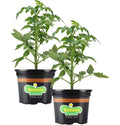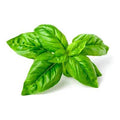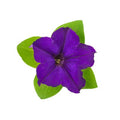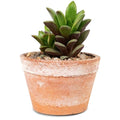- Regular price
- $17.99
- Regular price
-
- Sale price
- $17.99
- Unit price
- per
When gardeners talk about the "first" tomatoes, Early Girl is always there. This may be the most all-round popular hybrid to satisfy that itch for the first fresh tomato of the season. Use them for slicing on a place, into a salad, or on a sandwich. This a proven all-round early hybrid. Use it to jump start your harvest. Early Girl bears lots of fruit for early harvest, but because the vines are indeterminate, they continue producing through summer. In our Alabama test garden, where conditions are ideal and the growing season is long, we harvest an average of 300 tomatoes from each Early Girl plant! Many gardeners plant it again late in the summer so that it will produce a huge fresh crop of "fall tomatoes" quickly before frost.
Resistant to verticillium wilt (V) and fusarium wilt races 1 and 2 (F).
Read Less
Product Availability:
Out of Stock
Key Highlights
- LightFull Sun
- MaturesAt least 50 days after planting
- Fruit Size6 to 8 Ounces
- Plant SpacingAt least 36 inches apart
- Plant HeightTall (48″+)
- Planting TimeSpring, Summer
- Determinate/IndeterminateIndeterminate
- Annual/PerennialAnnual
- Pot MaterialGrowers
- SKU202051
How to Grow
Learn how to grow tomatoes. Get tips about growing tomatoes in the ground, raised beds, or containers. Care for tomato plants from planting to harvesting.
View Growing Tomatoes Guide
Delivery Information
Bonnie Plants are carefully packed for secure delivery to your home. All plants are shipped safely in packaging that's 100% recyclable.
Shipping may not be available for all plant varieties.

Support
Can’t find the answer you’re looking for? Visit our FAQs or chat with our friendly team.
Where do my Bonnie Plants® come from?
Not far from where you are! We have over 70 growing stations spread across the country, so our plants don’t have to travel far to make it to your garden. That means less time spent in transit, which is better for the plants and for the planet, too. What’s more, each growing station grows varieties that tend to perform well in that particular region, so you don’t have to wonder whether the Bonnie veggies and herbs you buy are suitable for the area you live in.
Does Bonnie sell GMO plants?
No. Every plant we sell is grown from non-GMO seed.
How do I know if a plant is suitable to grow in my area?
Most of the vegetable and herb plants we sell on this site can be grown outdoors throughout the Continental US - however it is important to transplant your starter plant at the right time based on the weather and climate in your area.
Many of our herb plants can also be grown indoors so long as you have sufficient light and water. If you grow herbs indoors, you will still need to transplant your herb plants into properly sized containers with added potting mix.
What is a USDA Hardiness Zone?
The 2012 USDA Plant Hardiness Zone Map is the standard by which gardeners and growers can determine which plants are most likely to thrive at a location. The map is based on the average annual minimum winter temperature, divided into 10-degree F zones.
To learn more, visit https://planthardiness.ars.usda.gov/
How do I care for my plants once I receive them?
Your plant will come with both a care sheet and a plant tag, which gives you information on plant spacing, watering, sunlight and other important considerations to get you started.
Bonnie also has in-depth "How to Grow" guides available here.
How often do I need to water my plants?
A good rule of thumb is an inch of water per week, either by rain or watering; in arid climates, double that. In hot weather, vegetables need even more water, up to about a half an inch extra per week for every 10 degrees that the average temperature is above 60 degrees. You can measure an inch of water by putting a rain gauge or other container under your sprinkler, soaker, drip, or other watering system. You’ve applied an inch of water when the vessel collects water an inch deep. Container gardens may need to be watered more frequently than in-ground garden beds, so check the soil each day and add water if the top inch or so of potting soil is dry.




 Herbs
Herbs
 Vegetables
Vegetables
 Fruit
Fruit
 Flowers
Flowers
 Succulents
Succulents

